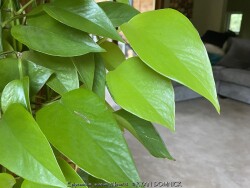

***Description for this plant available with future update!*** Epipremnum aureum 'Neon' is also known as Neon Pothos (Tropical).
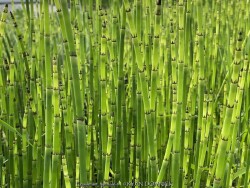

Horsetail Reed (Equisetum hyemale) is a very primitive "Dinosaur" plant with a one-of-a-kind appearance. Tube-like segmented stems grow vertical creating a dense bamboo-like appearance when grown properly in a pot or edging. The evergreen stems (down to -30 degrees F) are particularly noticeable in winter and can provide significant interest to the landscape. It is mostly used as a native erosion control plant in large areas along streams and wet wooded areas. For the home garden, the species is generally too aggressive to mix with other plants unless contained. The best use is as a marginal water garden plant in a sealed container. Horsetail rhizomes cannot spread thru open water or hop over an edge in the open air. If planted in the garden and once established, it is extremely difficult to remove by digging because its rhizomes spread wide and deep. Roundup is not effective against primitive plants such as horsetail and mosses. If planted in the garden, use professional soil barriers or no-fail sealed planters (no drainage holes ok) to restrict growth. Native to large portions of Eurasia, Canada and the U.S., including Kansas, equisetum is the single surviving genus of a class of primitive vascular plants dating back to the mid-Devonian period (350 + million years ago). As a plant evolved before twigs and leaves, Horsetail Reed is a non-flowering, seedless plant that reproduces by spores.
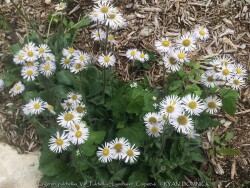

***Description for this perennial available with future update!***Robin's Plantain / Fleabane, is also known as Erigeron pulchellus var. pulchellus 'Lynnhaven Carpet'
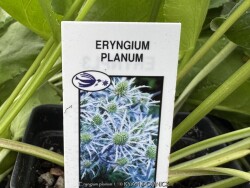

***Description for this perennial available with future update!*** Eryngium planum is also known as Sea Holly.
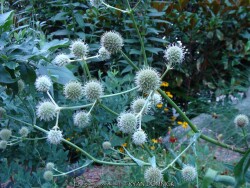

***Description for this perennial available with future update!***Rattlesnake Master / Eryngium, is also known as Eryngium yuccifolium
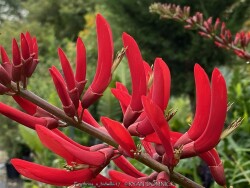

***Description for this hardy tropical available with future update!*** Erythrina x bidwillii is also known as Red Hybrid Coral Bean >>>>>>>>>>>In our trial gardens in Lawrence, KS (zone 6a), an established specimen planted on the south wall of a house with 6-12" of leaf mulch survived -17 degrees F. During the arctic blast of February, 2021, lows down to -17 degrees F on Feb 16th, 2021 were recorded. The longevity of this cold blast was also impressive: 10 days on a row with highs of 10-15 degrees F or lower, 8 nights of lows in the single digits and negatives, and 36 strait hours of 0 degrees F and mostly lower.
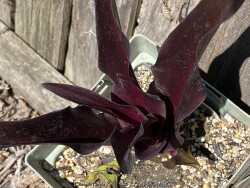

***Description for this hardy tropical available with future update!*** Eucomis 'Purple Reign' is also known as Purple Reign Pineapple Lily / Eucomis.
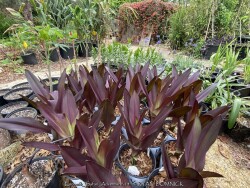

Safari Adventure Pineapple Lily (Eucomis comosa 'Safari Adventure') is typically grown for their wide tropical foliage and pineapple-like flowers. Deep purple foliage contrasts well with many other flower colors. The plants are temperate and subtropical herbaceous perennial bulbs native to areas with a summer wet season and dry winter. Pineapple Lily are hardy outside as a perennial when established and with minimal effort at least up to zone 6a. During the growing season, fertilize, water regularly, and plant in full sun. Plant these bulbs in the ground at least 6-8" deep with 3-4" of mulch to enjoy a wonderful tropical effect! Foliage may look bedwraggled by fall so it is ok to cut back foliage at that time. They can also be grown as a flowering summer patio plant. If growing as a potted plant and trying to overwinter, allowing the foliage to frost is ok, it will not kill the root system. However, do not allow the pot with rootball to freeze solid or go below 20 degrees for more than a few hours; move into a cold garage or basement over the winter with no watering. Cut back and allow to go dormant and place entire pot back out in April or May with a time-release fertilizer. Another more labor intensive way to overwinter pineapple lily is to remove them from the dirt, dust with fungicide, place in box with sawdust, and keep in the refrigerator. We consider this method old-fashioned and too much work but ok if you only want to save a few bulbs. If digging from the ground in colder zones, just save a big chunk with the dirt intact and place into a large pot in the garage.
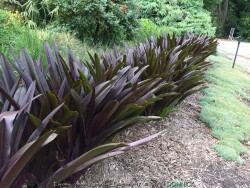

Sparkling Burgundy Pineapple Lily (Eucomis comosa 'Sparkling Burgundy') are typically grown for their wide tropical foliage and pineapple-like flowers. Deep purple foliage contrasts well with many other flower colors. The plants are temperate and subtropical herbaceous perennial bulbs native to areas with a summer wet season and dry winter. Pineapple Lily are hardy outside as a perennial when established and with minimal effort at least up to zone 6a. During the growing season, fertilize, water regularly, and plant in full sun. Plant these bulbs in the ground at least 6-8" deep with 3-4" of mulch to enjoy a wonderful tropical effect! Foliage may look bedwraggled by fall so it is ok to cut back foliage at that time. They can also be grown as a flowering summer patio plant. If growing as a potted plant and trying to overwinter, allowing the foliage to frost is ok, it will not kill the root system. However, do not allow the pot with rootball to freeze solid or go below 20 degrees for more than a few hours; move into a cold garage or basement over the winter with no watering. Cut back and allow to go dormant and place entire pot back out in April or May with a time-release fertilizer. Another more labor intensive way to overwinter pineapple lily is to remove them from the dirt, dust with fungicide, place in box with sawdust, and keep in the refrigerator. We consider this method old-fashioned and too much work but ok if you only want to save a few bulbs. If digging from the ground in colder zones, just save a big chunk with the dirt intact and place into a large pot in the garage. In our display garden in Lawrence, KS (zone 6a), an established specimen planted over 4-6" deep and mulched 2-3" with wood mulch survived -17 degrees F. During the arctic blast of February, 2021, lows down to -17 degrees F on Feb 16th, 2021 were recorded. The longevity of this cold blast was also impressive: 10 days on a row with highs of 10-15 degrees F or lower, 8 nights of lows in the single digits and negatives, and 36 straight hours of 0 degrees F and mostly lower. This eucomis has survived for over 10 years and other extreme cold blasts in the past.


Giant Pineapple Lily (Eucomis pallidiflora ssp. pole-evansii) are typically grown for their wide tropical foliage and giant pineapple-like flowers. Everything about this pineapple lily is large! Bright green foliage upto 3 feet tall contrasts well with many other flower colors. The plants are temperate and subtropical herbaceous perennial bulbs native to areas with a summer wet season and dry winter. Pineapple Lily are hardy outside as a perennial when established and with minimal effort at least up to zone 6a. During the growing season, fertilize, water regularly, and plant in full sun. Plant these bulbs in the ground at least 8-12" deep with 3-4" of mulch to enjoy a wonderful tropical effect! Foliage may look bedwraggled by fall so it is ok to cut back foliage at that time. They can also be grown as a flowering summer patio plant. If growing as a potted plant and trying to overwinter, allowing the foliage to frost is ok, it will not kill the root system. However, do not allow the pot with rootball to freeze solid or go below 20 degrees for more than a few hours; move into a cold garage or basement over the winter with no watering. Cut back and allow to go dormant and place entire pot back out in April or May with a time-release fertilizer. Another more labor intensive way to overwinter pineapple lily is to remove them from the dirt, dust with fungicide, place in box with sawdust, and keep in the refrigerator. We consider this method old-fashioned and too much work but ok if you only want to save a few bulbs. If digging from the ground in colder zones, just save a big chunk with the dirt intact and place into a large pot in the garage. In our display garden in Lawrence, KS (zone 6a), an established specimen planted over 4-6" deep and mulched 2-3" with wood mulch survived -17 degrees F. During the arctic blast of February, 2021, lows down to -17 degrees F on Feb 16th, 2021 were recorded. The longevity of this cold blast was also impressive: 10 days on a row with highs of 10-15 degrees F or lower, 8 nights of lows in the single digits and negatives, and 36 straight hours of 0 degrees F and mostly lower. This eucomis has survived for over 3 years now.
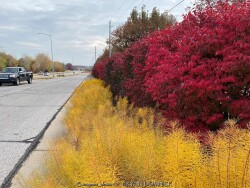

***Shrub descriptions available with future update!*** Euonymus alatus 'Fire Ball' is also known as Fire Ball Improved Burning Bush >>>>>>>>>>>> Spring Meadow Nursery says "Better stem hardiness than typical dwarf burning bush. Fire Ball® burning bush is an improved selection of compact burning bush with tighter branching and superior hardiness. Other varieties of burning bush may experience die-back during harsh winters; Fire Ball® euonymus has experienced zero damage even in the coldest of Midwestern winters"
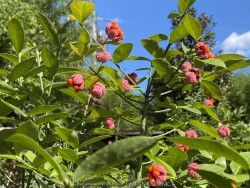

***Shrub descriptions available with future update!***Native Strawberry Bush, is also known as Euonymus americanus
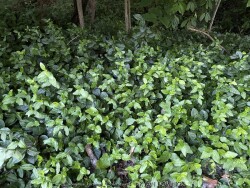

Purple Wintercreeper (Euonymus fortunei 'Coloratus') makes a durable evergreen groundcover that starts off slow, but grows quickly after a few years to forms a dense, weed-smothering mat of foliage. As one of the most dry-shade tolerant plants there is, it's thick leathery leaves seem to handle everything nature has to throw at it! That being said, beware that this is an extremely vigorous plant that crowds out most weeds and is itself weed-like, with a very spreading growth habit. After establishment, it is high maintenance if it has already filled the space and you don't want it to spread any further: it even resists Round-up! It will climb trees if you allow it, generally using it for support to allow its mature form to develop and flowering to occur. From there, red-orange seeds develop that are spread everywhere and will overrun nearby native forests in Eastern Kansas. For the home garden, the species is generally too aggressive to mix with other plants. At our plant nursery, since we cannot eradicate it, we have allowed it to cover a tall fence along the back of our property where it has crept in from the neighboring woods. It does form a nice evergreen screen as it weaves into the trees.
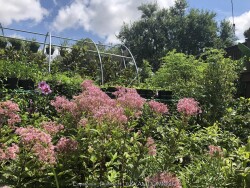

***Description for this perennial available with future update!***Phantom Dwarf Purple Eupatorium, is also known as Eupatorium 'Phantom'
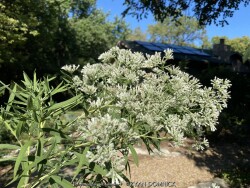

***Description for this perennial available with future update!*** Eupatorium altissimum is also known as Tall Boneset / Eupatorium.
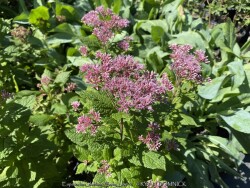

***Description for this perennial available with future update!***Little Joe Purple Eupatorium / Joe Pye, is also known as Eupatorium dubium 'Little Joe'
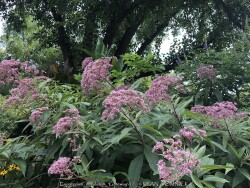

***Description for this perennial available with future update!***Gateway Purple Eupatorium / Joe Pye, is also known as Eupatorium maculatum 'Gateway'
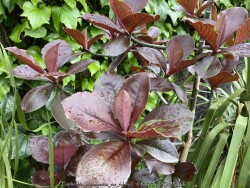

The velvety maroon foliage colors and patterns of Red-leaf African Milk Bush (Euphorbia bicompacta var. rubra) are amazing. Usually used as a patio or house plant in Kansas. Grow in full sun to full shade with optional extra watering including that which comes from rainfall. Plants with time to acclimate will thrive in full sun but be careful not to rush it or sunburning will occur. Generally if moving outside for the summer, allow 2-3 weeks of part shade or morning sun before placing in full sun. Repotting may or may not be needed depending on how large you want the plant to grow; plants can continue to grow taller and tolerate extremely root-bound pots but may need wind bracing. Potted plants are hardy to at least 25 degrees F for a short time if kept dry so you are ok if you miss the first light frost. Do not allow the pot with rootball to freeze solid though. Then move into a cold garage, basement, or bright window over the winter with occasional watering. As a winter house plant, it will look presentable all winter long with just a few waterings. As a permanent house plant, provide bright light and allow the soil to dry between waterings for many years of carefree enjoyment. Potted plants are very low maintenance needing very occasional pruning or topping. Leaves are filled with a milky sap which seems to flow out very vigorously even with only the tiniest injury. All members of the genus Euphorbia produce a milky sap called latex that is toxic and can range from a mild irritant to very poisonous.
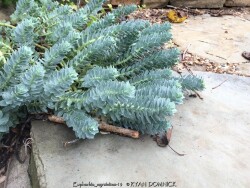

Donkeytail Spurge (Euphorbia myrsinites) is grown for its powder-blue/silver whorled foliage that is very architectural and symetrical. The stems creep along the ground in several directions from the main stem. Beautiful spring flowers are chartruse and foliage is solidly evergreen during winter and completely pest-free. Native to rocky and grassy places of southeastern Europe and Asia Minor, Donkeytail Spurge tolerates a wide range of growing conditions except excess moisture. Performance is best in poor soils, including rocky-sandy ones. Root rot can be a problem in poor drainage areas. It prefers full sun but can also grow well in full dry-shade. Individual plants tend to be short lived so allow some self seeding to occur within the group of plants. Due to self-seeding, it is considered a noxious weed in several western states and should not be planted in those areas. However, it is not a problem in Eastern Kansas or further East areas with over 35 inches of rainfall per year. Do not plant in rich moist soils or root rot will probably occur. Donkeytail Spurge is less adapted to consistent summer heat and humidity of zone 7b Southeast parts of the United States. With poisonous foliage, these plants resist deer and rabbit browsing. Wear gloves when handling this plant and avoid the milky sap. Great plant for berms or clammoring over retaining walls in hot West or South exposures in full sun or the opposite full dry-shade!


The Pencil Cactus (Euphorbia tirucalli) is a shrub with pencil-thick, green, smooth, succulent branches that provide photosynthesizes long after the foliage is shed. Usually grown as a patio or house plant in Kansas. Grow in full sun to full shade with optional extra watering including that which comes from rainfall. Plants with time to acclimate will thrive in full sun but be careful not to rush it or sunburning will occur. Generally if moving outside for the summer, allow 2-3 weeks of part shade or morning sun before placing in full sun. Repotting may or may not be needed depending on how large you want the plant to grow; plants can continue to grow taller and tolerate extremely root-bound pots but may need wind bracing. Potted plants are hardy to at least 25 degrees F for a short time if kept dry so you are ok if you miss the first light frost. Do not allow the pot with rootball to freeze solid though. Then move into a cold garage, basement, or bright window over the winter with occasional watering. As a winter house plant, it will look presentable all winter long with just a few waterings. As a permanent house plant, provide bright light and allow the soil to dry between waterings for many years of carefree enjoyment. Potted plants are very low maintenance needing very occasional pruning or topping. Stems are filled with a toxic milky sap which seems to flow out very vigorously even with only the tiniest injury. All members of the genus Euphorbia produce a milky sap called latex that is toxic and can range from a mild irritant to very poisonous. Firesticks Pencil Cactus (Euphorbia tirucalli 'Firesticks') is a highly ornamental variety that is more of a chartreuse color with bright orange and red tips developing in response to cold night temperatures.
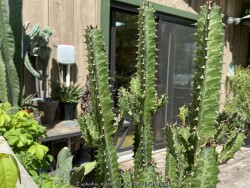

African Milk Tree (Euphorbia trigona) is a an easy care succulent tree that originates from West Africa. Its triangular columns make a fascinating architectural addition to the room or patio. Usually grown as a patio or house plant in Kansas. Grow in full sun to full shade with optional extra watering including that which comes from rainfall. Plants with time to acclimate will thrive in full sun but be careful not to rush it or sunburning will occur. Generally if moving outside for the summer, allow 2-3 weeks of part shade or morning sun before placing in full sun. Repotting may or may not be needed depending on how large you want the plant to grow; plants can continue to grow taller and tolerate extremely root-bound pots but may need wind bracing. Potted plants are hardy to at least 28 degrees F for a short time if kept dry so you are ok if you miss the first light frost. Do not allow the pot with rootball to freeze solid though. Then move into a cold garage, basement, or bright window over the winter with occasional watering. As a winter house plant, it will look presentable all winter long with just a few waterings. As a permanent house plant, provide bright light and allow the soil to dry between waterings for many years of carefree enjoyment. Potted plants are very low maintenance needing very occasional pruning or topping. Stems are filled with a toxic milky sap which seems to flow out very vigorously even with only the tiniest injury. All members of the genus Euphorbia produce a milky sap called latex that is toxic and can range from a mild irritant to very poisonous. No insect pests will bother this plant.
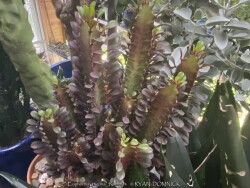

African Milk Tree (Euphorbia trigona) is a an easy care succulent tree that originates from West Africa. Its triangular columns make a fascinating architectural addition to the room or patio. Usually grown as a patio or house plant in Kansas. Grow in full sun to full shade with optional extra watering including that which comes from rainfall. Plants with time to acclimate will thrive in full sun but be careful not to rush it or sunburning will occur. Generally if moving outside for the summer, allow 2-3 weeks of part shade or morning sun before placing in full sun. Repotting may or may not be needed depending on how large you want the plant to grow; plants can continue to grow taller and tolerate extremely root-bound pots but may need wind bracing. Potted plants are hardy to at least 28 degrees F for a short time if kept dry so you are ok if you miss the first light frost. Do not allow the pot with rootball to freeze solid though. Then move into a cold garage, basement, or bright window over the winter with occasional watering. As a winter house plant, it will look presentable all winter long with just a few waterings. As a permanent house plant, provide bright light and allow the soil to dry between waterings for many years of carefree enjoyment. Potted plants are very low maintenance needing very occasional pruning or topping. Stems are filled with a toxic milky sap which seems to flow out very vigorously even with only the tiniest injury. All members of the genus Euphorbia produce a milky sap called latex that is toxic and can range from a mild irritant to very poisonous. No insect pests will bother this plant. Red African Milk Tree Cactus (Euphorbia trigona 'Rubra') is a fabulous red-leaf cultivar with reddish-maroon stems.


***Description for this perennial available with future update!***Variegated Fallopia, is also known as Fallopia japonica 'Variegata'
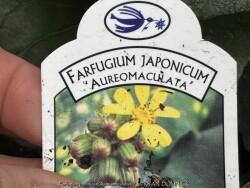

***Description for this plant available with future update!*** Farfugium japonicum 'Aureomaculatum' is also known as Yellow Variegated Leopard Plant / Tractor Seat Plant.


***Description for this plant available with future update!*** Farfugium japonicum 'Gigantea' is also known as Giant Leopard Plant / Tractor Seat Plant.
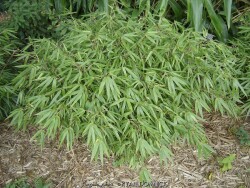

Dragon Head Bamboo (Fargesia rufa) is a wonderful relatively new bamboo introduction with bright green leaves, red sheaths on new canes, and most importantly, a CLUMPING growth habit. This plant creates a soft textured tropical lush appearance in the garden. This unique and interesting plant is evergreen to -5 degree F and grows to about 2-3 feet in Eastern Kansas. (the published 6-10 feet is only achieved in desirable more stable climates like Oregon) Fargesia rufa provides shelter for birds, is not troubled by any diseases, insects, or animals, and is resistant to drought and heat after established. In Eastern Kansas, typically our 40 inches of rainfall is sufficient without extra water if planted in good soils. It is best grown in organically rich, acidic, well-drained soils in part shade but tolerates full shade (not dry-shade). It prefers cool summer climates; although we are on the Southern edge of this plants adaptability, it still survives reasonably well here. Look for a cold microclimate planting location such as East or North exposure. It needs some morning sun but lots of protection from hot afternoon sun. Does not perform well in the hot and humid summers of the southeastern U.S. or anywhere south of zone 6b. I have witnesses plants die in zone 7a from summer heat exhaustion. Mulch in winter will provide protection for the roots and expect occasional die-back when temperatures hit -5 to -10 degrees F. Repeated or successive cold winters with complete foliage loss seem to be an issue with this and many evergreen zone 6/7 plants. One occasional difficult winter followed by mild winters is more tolerable. This plant, however, will generally recover in one summer with decent watering and fertilizer. Plants do not "run" in the landscape like traditional bamboo and are not invasive; think of it as an evergreen ornamental grass with a nice compact fountain-like appearance.
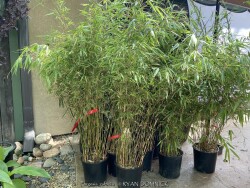

Dragon Head Bamboo (Fargesia rufa) is a wonderful relatively new bamboo introduction with bright green leaves, red sheaths on new canes, and most importantly, a CLUMPING growth habit. This plant creates a soft textured tropical lush appearance in the garden. This unique and interesting plant is evergreen to -5 degree F and grows to about 2-3 feet in Eastern Kansas. (the published 6-10 feet is only achieved in desirable more stable climates like Oregon) Fargesia rufa provides shelter for birds, is not troubled by any diseases, insects, or animals, and is resistant to drought and heat after established. In Eastern Kansas, typically our 40 inches of rainfall is sufficient without extra water if planted in good soils. It is best grown in organically rich, acidic, well-drained soils in part shade but tolerates full shade (not dry-shade). It prefers cool summer climates; although we are on the Southern edge of this plants adaptability, it still survives reasonably well here. Look for a cold microclimate planting location such as East or North exposure. It needs some morning sun but lots of protection from hot afternoon sun. Does not perform well in the hot and humid summers of the southeastern U.S. or anywhere south of zone 6b. I have witnesses plants die in zone 7a from summer heat exhaustion. Mulch in winter will provide protection for the roots and expect occasional die-back when temperatures hit -5 to -10 degrees F. Repeated or successive cold winters with complete foliage loss seem to be an issue with this and many evergreen zone 6/7 plants. One occasional difficult winter followed by mild winters is more tolerable. This plant, however, will generally recover in one summer with decent watering and fertilizer. Plants do not "run" in the landscape like traditional bamboo and are not invasive; think of it as an evergreen ornamental grass with a nice compact fountain-like appearance.
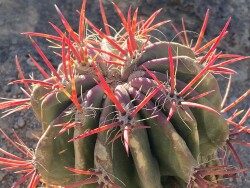

Fire Barrel Cacti (Ferocactus sp.) are known for their bright red spines. Native to the Mojave desert south to the desert of Baja California, it's usually grown as a patio or house plant in Kansas. In the wild, some fire barrel species are hardy to 20 degrees F. Grow in full sun with no extra watering except that which comes from rainfall. Repotting may or may not be needed depending on how large you want the plant to grow; plants can continue to grow taller and tolerate extremely root-bound pots but may need wind bracing. If repotting, make sure to use a sharp draining low organic cactus mix with plenty of sand and perlite. Potted plants are hardy to at least 25 degrees F for a short time if kept dry so you are ok if you miss the first light frost. Do not allow the pot with rootball to freeze solid though. Before extreme cold occurs, move to a bright interior window over the winter with no watering and keep above freezing. As a winter house plant, it will look presentable all winter long with just no waterings.(also to prevent lanky winter growth) As a permanent house plant, provide bright light and allow the soil to dry between waterings for many years of carefree enjoyment. Plants grown permanently indoors may begin to elongate stretching for light and lose their spine color. It can be hard to reproduce the intense UV sunlight they need so moving outside for the summer is best. Generally if moving outside for the summer, allow 1-2 weeks of part shade or morning sun before placing in full sun. Plants with time to acclimate will thrive in full sun but be careful not to rush it or sunburning will occur. Potted plants are very low maintenance but watch for scale and mealybugs that may hide beneath the cover of spines.
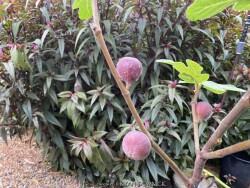

The common fig (Ficus carica) is native to an area extending from Asiatic Turkey to northern India. In Kansas, plant in a protected area near the house on south or west side but will survive in other locations in full hot sun. As an edible, ornamental plant, figs are an attractive bush-like plant with sandpapery green sometimes deeply lobed leaves. There is a slight and pleasant aroma when brushing against the foliage. Fruits are dark purple to maroon. Figs love full hot sun and are very drought tolerant but will produce more fruit if watered during the summer. Expect fig tree to die to the ground each year and start growing in May a bit later than other plants. Regrowth is rapid and established figs will have dozens of 5-6' water sprouts loaded with a few hundred fruits by September. You will always get a late summer/fall crop because fruit can come from new wood. If growing as a potted patio plant, grow in full sun with plenty of water during the summer. Then in late fall before temperatures get below 20 degrees F, move into a cold garage or basement over the winter with minimal watering. Do not allow the pot with rootball to freeze solid or go below 15 degrees for more than a few hours. By March or April, the fig will be trying to grow and you may put back outside (protect from late frosts) and you will also have a spring fruit crop. Eat fresh, freeze for fruit smoothies, or dry in sun or food dehydrator. In our trial gardens in Lawrence, KS (zone 6a), several established specimens planted 5-10 years ago and mulched 1-3" with wood mulch survived -17 degrees F. During the arctic blast of February, 2021, lows down to -17 degrees F on Feb 16th, 2021 were recorded. The longevity of this cold blast was also impressive: 10 days on a row with highs of 10-15 degrees F or lower, 8 nights of lows in the single digits and negatives, and 36 straight hours of 0 degrees F and mostly lower. 'Chicago Hardy' is considered to be one of the hardiest edible figs producing reliable fruits. It's stems are hardy to 10°F and the roots are hardy to -20°F. Sometimes if prolonged September cold-fronts occur and temperatures are too low at night, green fruits will disappointingly stop ripening. Look for a hot planting location microclimate such as a West or South wall to encourage fruit to ripen. Ripening does not continue to progress if harvested early (when fruit has any green coloring present).
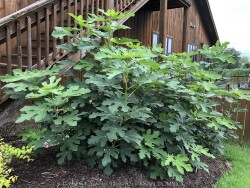

The common fig (Ficus carica) is native to an area extending from Asiatic Turkey to northern India. In Kansas, plant in a protected area near the house on south or west side but will survive in other locations in full hot sun. As an edible, ornamental plant, figs are an attractive bush-like plant with sandpapery green sometimes deeply lobed leaves. There is a slight and pleasant aroma when brushing against the foliage. Fruits are dark purple to maroon. Figs love full hot sun and are very drought tolerant but will produce more fruit if watered during the summer. Expect fig tree to die to the ground each year and start growing in May a bit later than other plants. Regrowth is rapid and established figs will have dozens of 5-6' water sprouts loaded with a few hundred fruits by September. You will always get a late summer/fall crop because fruit can come from new wood. If growing as a potted patio plant, grow in full sun with plenty of water during the summer. Then in late fall before temperatures get below 20 degrees F, move into a cold garage or basement over the winter with minimal watering. Do not allow the pot with rootball to freeze solid or go below 15 degrees for more than a few hours. By March or April, the fig will be trying to grow and you may put back outside (protect from late frosts) and you will also have a spring fruit crop. Eat fresh, freeze for fruit smoothies, or dry in sun or food dehydrator. In our trial gardens in Lawrence, KS (zone 6a), several established specimens planted 5-10 years ago and mulched 1-3" with wood mulch survived -17 degrees F. During the arctic blast of February, 2021, lows down to -17 degrees F on Feb 16th, 2021 were recorded. The longevity of this cold blast was also impressive: 10 days on a row with highs of 10-15 degrees F or lower, 8 nights of lows in the single digits and negatives, and 36 straight hours of 0 degrees F and mostly lower. 'Chicago Hardy' is considered to be one of the hardiest edible figs producing reliable fruits. It's stems are hardy to 10°F and the roots are hardy to -20°F. Sometimes if prolonged September cold-fronts occur and temperatures are too low at night, green fruits will disappointingly stop ripening. Look for a hot planting location microclimate such as a West or South wall to encourage fruit to ripen. Ripening does not continue to progress if harvested early (when fruit has any green coloring present).
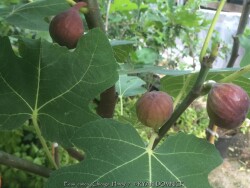

The common fig (Ficus carica) is native to an area extending from Asiatic Turkey to northern India. In Kansas, plant in a protected area near the house on south or west side but will survive in other locations in full hot sun. As an edible, ornamental plant, figs are an attractive bush-like plant with sandpapery green sometimes deeply lobed leaves. There is a slight and pleasant aroma when brushing against the foliage. Fruits are dark purple to maroon. Figs love full hot sun and are very drought tolerant but will produce more fruit if watered during the summer. Expect fig tree to die to the ground each year and start growing in May a bit later than other plants. Regrowth is rapid and established figs will have dozens of 5-6' water sprouts loaded with a few hundred fruits by September. You will always get a late summer/fall crop because fruit can come from new wood. If growing as a potted patio plant, grow in full sun with plenty of water during the summer. Then in late fall before temperatures get below 20 degrees F, move into a cold garage or basement over the winter with minimal watering. Do not allow the pot with rootball to freeze solid or go below 15 degrees for more than a few hours. By March or April, the fig will be trying to grow and you may put back outside (protect from late frosts) and you will also have a spring fruit crop. Eat fresh, freeze for fruit smoothies, or dry in sun or food dehydrator. In our trial gardens in Lawrence, KS (zone 6a), several established specimens planted 5-10 years ago and mulched 1-3" with wood mulch survived -17 degrees F. During the arctic blast of February, 2021, lows down to -17 degrees F on Feb 16th, 2021 were recorded. The longevity of this cold blast was also impressive: 10 days on a row with highs of 10-15 degrees F or lower, 8 nights of lows in the single digits and negatives, and 36 straight hours of 0 degrees F and mostly lower. 'Chicago Hardy' is considered to be one of the hardiest edible figs producing reliable fruits. It's stems are hardy to 10°F and the roots are hardy to -20°F. Sometimes if prolonged September cold-fronts occur and temperatures are too low at night, green fruits will disappointingly stop ripening. Look for a hot planting location microclimate such as a West or South wall to encourage fruit to ripen. Ripening does not continue to progress if harvested early (when fruit has any green coloring present).
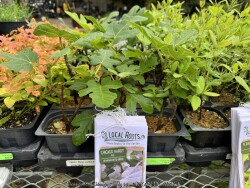

The common fig (Ficus carica) is native to an area extending from Asiatic Turkey to northern India. In Kansas, plant in a protected area near the house on south or west side but will survive in other locations in full hot sun. As an edible, ornamental plant, figs are an attractive bush-like plant with sandpapery green sometimes deeply lobed leaves. There is a slight and pleasant aroma when brushing against the foliage. Fruits are dark purple to maroon. Figs love full hot sun and are very drought tolerant but will produce more fruit if watered during the summer. Expect fig tree to die to the ground each year and start growing in May a bit later than other plants. Regrowth is rapid and established figs will have dozens of 5-6' water sprouts loaded with a few hundred fruits by September. You will always get a late summer/fall crop because fruit can come from new wood. If growing as a potted patio plant, grow in full sun with plenty of water during the summer. Then in late fall before temperatures get below 20 degrees F, move into a cold garage or basement over the winter with minimal watering. Do not allow the pot with rootball to freeze solid or go below 15 degrees for more than a few hours. By March or April, the fig will be trying to grow and you may put back outside (protect from late frosts) and you will also have a spring fruit crop. Eat fresh, freeze for fruit smoothies, or dry in sun or food dehydrator. In our trial gardens in Lawrence, KS (zone 6a), several established specimens planted 5-10 years ago and mulched 1-3" with wood mulch survived -17 degrees F. During the arctic blast of February, 2021, lows down to -17 degrees F on Feb 16th, 2021 were recorded. The longevity of this cold blast was also impressive: 10 days on a row with highs of 10-15 degrees F or lower, 8 nights of lows in the single digits and negatives, and 36 straight hours of 0 degrees F and mostly lower. 'Chicago Hardy' is considered to be one of the hardiest edible figs producing reliable fruits. It's stems are hardy to 10°F and the roots are hardy to -20°F. Sometimes if prolonged September cold-fronts occur and temperatures are too low at night, green fruits will disappointingly stop ripening. Look for a hot planting location microclimate such as a West or South wall to encourage fruit to ripen. Ripening does not continue to progress if harvested early (when fruit has any green coloring present).
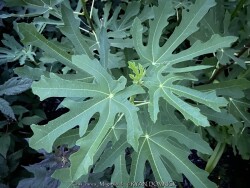

The common fig (Ficus carica) is native to an area extending from Asiatic Turkey to northern India. In Kansas, plant in a protected area near the house on south or west side but will survive in other locations in full hot sun. As an edible, ornamental plant, figs are an attractive bush-like plant with sandpapery green sometimes deeply lobed leaves. There is a slight and pleasant aroma when brushing against the foliage. Fruits are dark purple to maroon. Figs love full hot sun and are very drought tolerant but will produce more fruit if watered during the summer. Expect fig tree to die to the ground each year and start growing in May a bit later than other plants. Regrowth is rapid and established figs will have dozens of 5-6' water sprouts loaded with a few hundred fruits by September. You will always get a late summer/fall crop because fruit can come from new wood. If growing as a potted patio plant, grow in full sun with plenty of water during the summer. Then in late fall before temperatures get below 20 degrees F, move into a cold garage or basement over the winter with minimal watering. Do not allow the pot with rootball to freeze solid or go below 15 degrees for more than a few hours. By March or April, the fig will be trying to grow and you may put back outside (protect from late frosts) and you will also have a spring fruit crop. Eat fresh, freeze for fruit smoothies, or dry in sun or food dehydrator. In our trial gardens in Lawrence, KS (zone 6a), three specimens planted in 2020 and mulched 1-3" with wood mulch. Surprisingly, they survived -17 degrees F. During that arctic blast of February, 2021, lows down to -17 degrees F on Feb 16th, 2021 were recorded. The longevity of this cold blast was also impressive: 10 days on a row with highs of 10-15 degrees F or lower, 8 nights of lows in the single digits and negatives, and 36 straight hours of 0 degrees F and mostly lower. Magnolia Large Fruiting Fig (Ficus carica 'Magnolia') has slightly larger more deeply lobed foliage that is more ornamental. The fruit is large with brown skin and amber pulp. Pick the fruit just before maturity for a perfect flavor and to avoid souring and splitting. Sometimes if prolonged September cold-fronts occur and temperatures are too low at night, green fruits will disappointingly stop ripening. Look for a hot planting location microclimate such as a West or South wall to encourage fruit to ripen. Ripening does not continue to progress if harvested early (when fruit has any green coloring present).
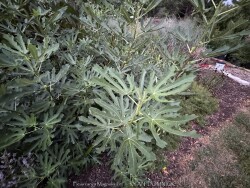

The common fig (Ficus carica) is native to an area extending from Asiatic Turkey to northern India. In Kansas, plant in a protected area near the house on south or west side but will survive in other locations in full hot sun. As an edible, ornamental plant, figs are an attractive bush-like plant with sandpapery green sometimes deeply lobed leaves. There is a slight and pleasant aroma when brushing against the foliage. Fruits are dark purple to maroon. Figs love full hot sun and are very drought tolerant but will produce more fruit if watered during the summer. Expect fig tree to die to the ground each year and start growing in May a bit later than other plants. Regrowth is rapid and established figs will have dozens of 5-6' water sprouts loaded with a few hundred fruits by September. You will always get a late summer/fall crop because fruit can come from new wood. If growing as a potted patio plant, grow in full sun with plenty of water during the summer. Then in late fall before temperatures get below 20 degrees F, move into a cold garage or basement over the winter with minimal watering. Do not allow the pot with rootball to freeze solid or go below 15 degrees for more than a few hours. By March or April, the fig will be trying to grow and you may put back outside (protect from late frosts) and you will also have a spring fruit crop. Eat fresh, freeze for fruit smoothies, or dry in sun or food dehydrator. In our trial gardens in Lawrence, KS (zone 6a), three specimens planted in 2020 and mulched 1-3" with wood mulch. Surprisingly, they survived -17 degrees F. During that arctic blast of February, 2021, lows down to -17 degrees F on Feb 16th, 2021 were recorded. The longevity of this cold blast was also impressive: 10 days on a row with highs of 10-15 degrees F or lower, 8 nights of lows in the single digits and negatives, and 36 straight hours of 0 degrees F and mostly lower. Magnolia Large Fruiting Fig (Ficus carica 'Magnolia') has slightly larger more deeply lobed foliage that is more ornamental. The fruit is large with brown skin and amber pulp. Pick the fruit just before maturity for a perfect flavor and to avoid souring and splitting. Sometimes if prolonged September cold-fronts occur and temperatures are too low at night, green fruits will disappointingly stop ripening. Look for a hot planting location microclimate such as a West or South wall to encourage fruit to ripen. Ripening does not continue to progress if harvested early (when fruit has any green coloring present).
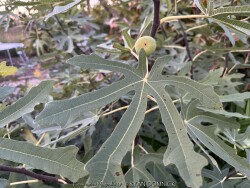

The common fig (Ficus carica) is native to an area extending from Asiatic Turkey to northern India. In Kansas, plant in a protected area near the house on south or west side but will survive in other locations in full hot sun. As an edible, ornamental plant, figs are an attractive bush-like plant with sandpapery green sometimes deeply lobed leaves. There is a slight and pleasant aroma when brushing against the foliage. Fruits are dark purple to maroon. Figs love full hot sun and are very drought tolerant but will produce more fruit if watered during the summer. Expect fig tree to die to the ground each year and start growing in May a bit later than other plants. Regrowth is rapid and established figs will have dozens of 5-6' water sprouts loaded with a few hundred fruits by September. You will always get a late summer/fall crop because fruit can come from new wood. If growing as a potted patio plant, grow in full sun with plenty of water during the summer. Then in late fall before temperatures get below 20 degrees F, move into a cold garage or basement over the winter with minimal watering. Do not allow the pot with rootball to freeze solid or go below 15 degrees for more than a few hours. By March or April, the fig will be trying to grow and you may put back outside (protect from late frosts) and you will also have a spring fruit crop. Eat fresh, freeze for fruit smoothies, or dry in sun or food dehydrator. In our trial gardens in Lawrence, KS (zone 6a), three specimens planted in 2020 and mulched 1-3" with wood mulch. Surprisingly, they survived -17 degrees F. During that arctic blast of February, 2021, lows down to -17 degrees F on Feb 16th, 2021 were recorded. The longevity of this cold blast was also impressive: 10 days on a row with highs of 10-15 degrees F or lower, 8 nights of lows in the single digits and negatives, and 36 straight hours of 0 degrees F and mostly lower. Magnolia Large Fruiting Fig (Ficus carica 'Magnolia') has slightly larger more deeply lobed foliage that is more ornamental. The fruit is large with brown skin and amber pulp. Pick the fruit just before maturity for a perfect flavor and to avoid souring and splitting. Sometimes if prolonged September cold-fronts occur and temperatures are too low at night, green fruits will disappointingly stop ripening. Look for a hot planting location microclimate such as a West or South wall to encourage fruit to ripen. Ripening does not continue to progress if harvested early (when fruit has any green coloring present).
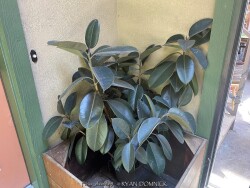

***Description for this plant available with future update!*** Ficus elastica is also known as Indian Rubberplant (Tropical).
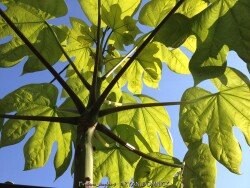

Chinese Parasol Tree (Firmiana simplex) is typically grown as a hardy tropical with huge green leaves and bright green stems that last through winter. This "die to the ground each winter" tree is even more impressive from water strout shoots from the ground. When grown in Kansas, it can be used as summer patio plant tolerating root-boundness well. Water regularly and place in full sun or part shade and enjoy all summer long into late fall. Potted plants are hardy to at least 25 degrees F for a short time if kept dry so you can wait awhile to move these in for the winter. Do not allow the pot with rootball to freeze solid though. Move into a cold garage or basement over the winter. Provide minimal watering and allow the foliage to go dormant and drop off if not already. Bright green stems will remain and add interest during winter. Place back out in April or May with a time-release fertilizer. Landscapers mainly plant Chinese Parasol "Tree" as a die-back to the ground woody perennial "tree". Even without mulch, it is easy to overwinter Firmiana simplex in the ground in Kansas as a woody perennial; complete die-back happens every 1-2 years. The resulting water sprouts from the ground create a bold tropical effect with robust bright green shoots resembling pool cue sticks reaching 5-8' in one season from a 3gal container! We have measured leaves up to 36" long aranded in whorls along the stems. Plants can exceed 15 feet with two consecutive years with no die-back when planted on a South wall. In Eastern Kansas, typically our 40 inches of rainfall is sufficient without extra water in good soils. Chinese Parasol Tree has been planted in our trial gardens and at several residential gardens in Lawrence, KS (zone 6a) 5-10 years ago. During the arctic blast of February, 2021, lows down to -17 degrees F on Feb 16th, 2021 were recorded. The longevity of this cold blast was also impressive: 10 days on a row with highs of 10-15 degrees F or lower, 8 nights of lows in the single digits and negatives, and 36 straight hours of 0 degrees F and mostly lower. Most plants survived with complete die-back and new spring water sprouts. This species is an aggressive, invasive weed in the warmer parts of North America south of zone 7b but not in Kansas because seeds never have a chance to form. Taking 5-7 years to reach flowering size, die-back is much more frequent than that in zone 6. Wow, what a "releaf"!


Chinese Parasol Tree (Firmiana simplex) is typically grown as a hardy tropical with huge green leaves and bright green stems that last through winter. This "die to the ground each winter" tree is even more impressive from water strout shoots from the ground. When grown in Kansas, it can be used as summer patio plant tolerating root-boundness well. Water regularly and place in full sun or part shade and enjoy all summer long into late fall. Potted plants are hardy to at least 25 degrees F for a short time if kept dry so you can wait awhile to move these in for the winter. Do not allow the pot with rootball to freeze solid though. Move into a cold garage or basement over the winter. Provide minimal watering and allow the foliage to go dormant and drop off if not already. Bright green stems will remain and add interest during winter. Place back out in April or May with a time-release fertilizer. Landscapers mainly plant Chinese Parasol "Tree" as a die-back to the ground woody perennial "tree". Even without mulch, it is easy to overwinter Firmiana simplex in the ground in Kansas as a woody perennial; complete die-back happens every 1-2 years. The resulting water sprouts from the ground create a bold tropical effect with robust bright green shoots resembling pool cue sticks reaching 5-8' in one season from a 3gal container! We have measured leaves up to 36" long aranded in whorls along the stems. Plants can exceed 15 feet with two consecutive years with no die-back when planted on a South wall. In Eastern Kansas, typically our 40 inches of rainfall is sufficient without extra water in good soils. Chinese Parasol Tree has been planted in our trial gardens and at several residential gardens in Lawrence, KS (zone 6a) 5-10 years ago. During the arctic blast of February, 2021, lows down to -17 degrees F on Feb 16th, 2021 were recorded. The longevity of this cold blast was also impressive: 10 days on a row with highs of 10-15 degrees F or lower, 8 nights of lows in the single digits and negatives, and 36 straight hours of 0 degrees F and mostly lower. Most plants survived with complete die-back and new spring water sprouts. This species is an aggressive, invasive weed in the warmer parts of North America south of zone 7b but not in Kansas because seeds never have a chance to form. Taking 5-7 years to reach flowering size, die-back is much more frequent than that in zone 6. Wow, what a "releaf"!
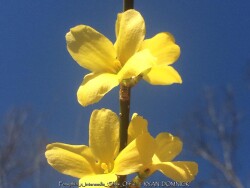

Show Off® Forsythia (Forsythia x Mindor 'Show Off') "shows off" its bright yellow early spring flowers. Improved flower display compared to older varieties. Compact. Deer resistant. Good for cut displays. An excellent specimen plant for mixed borders and foundations. Prefers a good loose soil, but will do well in any soil. pH adaptable and withstands city conditions and is air pollution tolerant. Pruning is best done immediately after flowering. Old stems can be removed or can be cut back to the ground. Shaping should be done at this time. Prefers medium moisture. Fertilize in early spring by applying a slow release fertilizer specialized for trees and shrubs. Follow the label for recommended rate of application. This little beauty will be a blast of early spring color from the ground up! Show Off is not your typical forsythia! It is compact and full of blooms from the ground to the end of every stem. Older varieties can become out of control and often become victims of bad pruning; this little beauty will stay small so there is less need to prune. Now you can have a nice tight, compact forsythia hedge without doing any work! A real improvement over older varieties, Show Off is a very showy choice for the early spring garden. In Eastern Kansas, this cultivar performs WELL with just about everything nature has to challenge it! All Proven Winners® plants are legally propagated, healthy and vigorous, true to name, and tagged with color pictures and growing information.
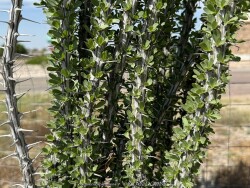

Ocotillo in also known as Fouquieria splendens Not a true cactus but more of a drought deciduous shrub, ocotillo is native to the Mojave desert south to the desert of Baja California, it's usually grown as a patio or house plant in Kansas. In the wild, established species are hardy to 10 degrees F. Grow in full sun with no extra watering except that which comes from rainfall. Repotting may or may not be needed depending on how large you want the plant to grow; plants can continue to grow taller and tolerate extremely root-bound pots but may need wind bracing. If repotting, make sure to use a sharp draining low organic cactus mix with plenty of sand and perlite. Potted plants are hardy to at least 25 degrees F for a short time if kept dry so you are ok if you miss the first light frost. Do not allow the pot with rootball to freeze solid though. Before extreme cold occurs, move to a bright interior window over the winter with no watering and keep above freezing. As a winter house plant, it will look presentable all winter long with just no waterings.(also to prevent lanky winter growth) As a permanent house plant, provide bright light and allow the soil to dry between waterings for many years of carefree enjoyment. Plants grown permanently indoors may begin to elongate stretching for light and lose their color. It can be hard to reproduce the intense UV sunlight they need so moving outside for the summer is best. Generally if moving outside for the summer, allow 1-2 weeks of part shade or morning sun before placing in full sun. Plants with time to acclimate will thrive in full sun but be careful not to rush it or sunburning will occur. Potted plants are very low maintenance.
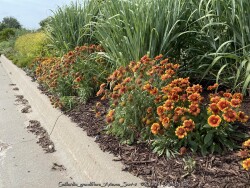

Arizona Sun Blanket Flower (Gaillardia aristata 'Arizona Sun') is an improved variety with an intense covering of red and yellow flowers in the summer. Blooming usually starts during the heat of summer and continues until frost. Foliage is mint green and attractive. Blanket flower is native to dry sandy areas of the lower great plains including Texas, New Mexico, and Arizona. Because of its desert heritage, it resents cold wet winters and needs well drained sandy, silty, or rocky soil. Short periods of extra water is tolerated in the heat of summer especially after blooming has started. It will typically grow in any soil and bloom like crazy during the summer making it very useful even as an annual if planted in the wrong soil type. In Kansas landscapes, it is commonly used as an annual or short-lived perennial where lots of color is needed in full sun. Self-seeding is possible in areas that are not mulched. Gaillardia combines nicely with any blue or purple flower including catmint, false indigo, plumbago.
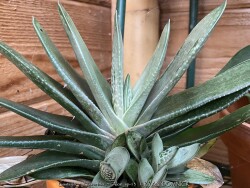

These succulents are usually spineless and grown for their beautiful shapes, color and texture. Gasteria / Haworthia / Aloe are usually grown as small patio or house plants in Kansas. In the wild, some species are hardy to below 20 degrees F. Grow in part sun to full shade with little extra watering except that which comes from rainfall. Repotting may or may not be needed depending on how large you want the plant to grow; plants can continue to grow and tolerate extremely root-bound pots but will eventually need thinned or repotted. If repotting, make sure to use a sharp draining low organic cactus mix with plenty of sand and perlite. To play is safe, potted plants are best moved in before night temperatures get below 45 degrees F. It is important to avoid the combination of wet and cold. Move to a bright interior window over the winter with no watering and keep above freezing. As a winter house plant, it will look presentable all winter long with just a few waterings. As a permanent house plant, provide bright light and allow the soil to dry between waterings for many years of carefree enjoyment. Generally if moving outside for the summer, keep in part to full shade. Some species will acclimate and thrive in full sun but be careful not to rush it or sunburning will occur; move into sun gradually over a few weeks. Potted plants are very low maintenance but avoid too much water or plants will rot.
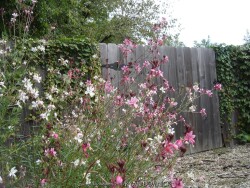

***Description for this perennial available with future update!*** Gaura lindheimeri is also known as White / Pink Native Gaura.
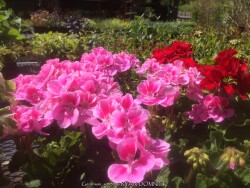

***Description for this plant available with future update!*** Geranium / Pelargonium sp. is also known as Mixed Geranium (Tropical).
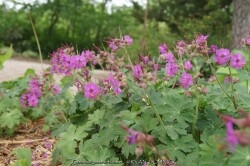

Geranium macrorrhizum, commonly called Bigroot Geranium is native to the Southeast Alps and the Balkans. It features highly aromatic fuzzy leaves that leave you wanting another sniff after crushing a leaf in your hand. Early summer pink, rose, or white flowers form depending on the cultivar. It forms a weed-suppressing mat of rhizomatous semi-evergreen perennial that typically grows to 12" tall but spreads to 24" wide. Root rot can be a problem in poor drainage areas. Bigroot Geranium is the most drought tolerant of the hardy geraniums earning a spot in the dry shade garden; it cannot handle extreme drought or extremely rootbound soils though. It prefers average to dry garden conditions with dappled or morning sun. Sun burning is possible with temperatures over 100° so avoid full afternoon sun. Plantings can thrive for decades if in the right spot as there is no such thing as overcrowding for Big Root Geranium. When planted in mass, growth is slow at first but eventually a cake-like rhizome system will form and completely smother out any weeds and compete well with trees for water and nutrients. The growth rate is slow at first so space new plants relatively close together is desiring this effect.
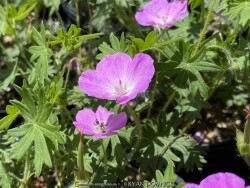

***Description for this perennial available with future update!*** Geranium sanguineum is also known as Hardy Geranium / Bloody Cranesbill.
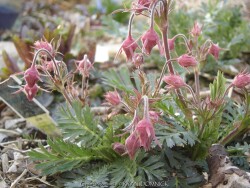

***Description for this perennial available with future update!***Prairie Smoke Geum, is also known as Geum triflorum
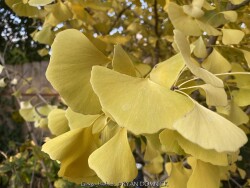

***Tree descriptions available with future update!***>>>Ginkgo, is also known as Ginkgo biloba. Ginkgo is not tolerant of late-spring frosts, because there are no reserve vegetative buds‚¬€they leaf out all at once. When such a frost destroys these buds and leaves, it can take until midsummer before the tree has had enough time to produce new ones.
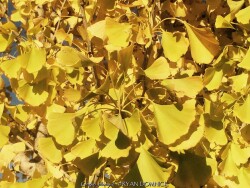

***Tree descriptions available with future update!*** Ginkgo biloba 'Autumn Gold' is also known as Autumn Gold Male Ginkgo


Raintree Hardy Gladiolus (Gladiolus 'Raintree') are typically grown for their mid-summer flowers and vertical iris-leaf foliage. The plants are temperate and subtropical herbaceous perennial bulbs native to areas with a summer wet season and dry winter. Gladiolus are hardy outside as a perennial when established and with minimal effort at least up to zone 6a. During the growing season, fertilize, water regularly, and plant in full sun. Plant these bulbs in the ground at least 6-8" deep with 3-4" of mulch to enjoy a wonderful tropical flowering effect! Foliage may look bedwraggled by fall so it is ok to cut back foliage at that time. They can also be grown as a flowering summer patio plant. If growing as a potted plant and trying to overwinter, allowing the foliage to frost is ok, it will not kill the root system. However, do not allow the pot with rootball to freeze solid or go below 20 degrees for more than a few hours; move into a cold garage or basement over the winter with no watering. Cut back and allow to go dormant and place entire pot back out in April or May with a time-release fertilizer. Another more labor intensive way to overwinter gladiolus is to remove them from the dirt, dust with fungicide, place in box with sawdust, and keep in the refrigerator. We consider this method old-fashioned and too much work but ok if you only want to save a few bulbs. If digging from the ground in colder zones, just save a big chunk with the dirt intact and place into a large pot in the garage. In a customer's garden in Lawrence, KS (zone 6a), four established specimens planted over 4-6" deep and mulched 2-3" with wood mulch survived -17 degrees F. During the arctic blast of February, 2021, lows down to -17 degrees F on Feb 16th, 2021 were recorded. The longevity of this cold blast was also impressive: 10 days on a row with highs of 10-15 degrees F or lower, 8 nights of lows in the single digits and negatives, and 36 straight hours of 0 degrees F and mostly lower. We plan to propagate these 'Raintree' clones in 2022-2023.